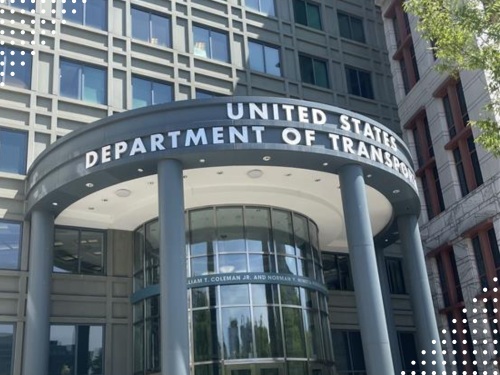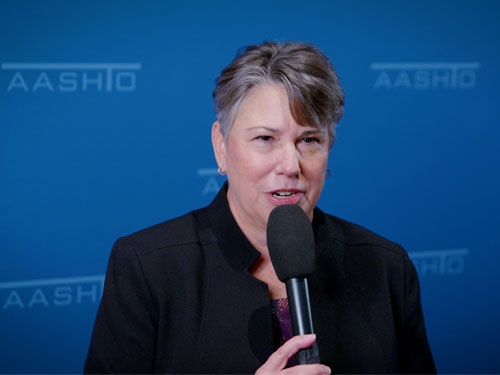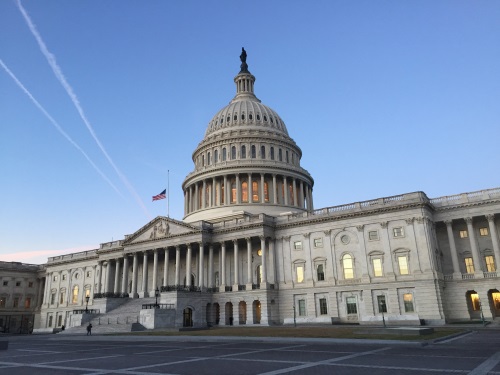A hearing held February 15 by a House of Representatives Committee on Ways and Means subcommittee examined the current and future economic impact of federal infrastructure investment.
[Above photo by AASHTO]
Representatives from the American Association of State Highway and Transportation Officials shared their perspectives on that topic during the Subcommittee on Select Revenue Measures hearing – specifically on the benefits of the $1.2 trillion Infrastructure Investment and Jobs Act or IIJA signed into law in November 2021.

Shawn Wilson, Ph.D. – secretary of the Louisiana Department of Transportation and Development and AASHTO’s 2021-2022 president – noted at the hearing that state DOTs are going through a broad “readjustment” that may prove critical to fully implementing the IIJA.
“Workforce development is an urgent and critical issue for state DOTs,” he explained in his remarks. “While the IIJA provided an increase in funding to state DOTs, the ability to effectively utilize these resources depends upon having the necessary workforce in place.”
That is why Wilson stressed that restructuring, increased diversity and inclusion, greater employee buy-in and collaboration, and organizational culture change may be required for state DOTs to succeed in the future.
He also noted that the IIJA focuses fiscal resources on two key issues: infrastructure resiliency and broadband deployment.
“When it comes to resiliency, the number and cost of natural disasters in the United States continue to increase at record-setting rates,” he said. “Given the importance of the transportation system not only in connecting those areas hard-hit by disasters with relief supplies, but also in linking communities with evacuation routes, state DOTs are on the frontlines of disaster response.”
Where broadband deployment is concerned, Wilson emphasized that the COVID-19 pandemic “has changed our economy,” and with it the way people learn, access healthcare, and conduct everyday activities.
“Nationwide, even if we may not be the lead state broadband agency, AASHTO members want to be part of the conversation to provide equal access to information and resources now and into the future,” he said.

Building on those themes, Victoria Sheehan – commissioner of the New Hampshire Department of Transportation and immediate past president of AASHTO – emphasized the key role state and local funding play in maintaining the nation’s transportation system.
“While the IIJA funding is important, in the transportation sector federal dollars play a relatively small role compared to the total investment made in the United States,” she said – pointing out that, according to the Congressional Budget Office, only 22.3 percent of total transportation funding for capital, operations and maintenance activities comes from the federal government.
“The remainder represents state and local government funding,” Sheehan emphasized. “In fact, viewing state investment in local and off-system projects only through the federal funding lens fails to reflect the full scope of state investments made on local transportation assets.”
She noted that the IIJA is positioned to provide key support to those state and local infrastructure investment efforts – especially through programs such as the new $27 billion Bridge Formula Program.
“Focusing on preservation, rehabilitation, and replacement of existing infrastructure has limited our capacity to deliver other types of projects that are important to communities,” Sheehan said. “With the dedicated bridge funds provided in the IIJA, we can now increase our investment in bridges, advance bridge work, and complete projects sooner.”
AASHTO noted that concerted efforts by every state DOT over the past decade resulted in the number of bridges in poor condition decreasing by 18 percent, while the amount of interstate pavement in good condition increased by 10 percent.
However, much of the IIJA’s addition infrastructure funding remains in limbo as Congress has failed to pass a full fiscal year 2022 appropriations package – relying instead on a broad continuing resolution or CR that maintains infrastructure funding at FY 2021 levels.

“Given the public’s high expectations of the IIJA, we are concerned that many of its programs cannot be put to use until the full FY 2022 appropriations package is enacted,” noted Joung Lee, AASHTO’s deputy director and chief policy officer, in his opening remarks at the hearing.
“Without it, states, local governments, and public transit agencies will not be able to access the IIJA’s 20 percent funding increase for highway formula and 30-plus percent increase for public transit formula programs, along with new transportation initiatives in the law,” he said.
Even with IIJA enactment, Lee stressed that the nation continues to struggle with the solvency of the federal Highway Trust Fund or HTF – a key fiscal mechanism supporting current and future transportation projects.
“With $272 billion transferred from the General Fund to keep it [the HTF] solvent since 2008, we recognize the urgent need for a permanent revenue solution to stabilize our transportation investment for the long term,” he said.
Lee noted that Congressional Budget Office analysis indicates dedicated HTF revenues – including the federal tax on diesel and gasoline fuels – will only be able to support about half of ongoing spending, and the trust fund will face a $215 billion cumulative cash shortfall through 2031.
“That is why AASHTO strongly supports the new National Motor Vehicle Per-Mile User Fee Pilot program in the IIJA,” he added. “State DOTs are at the forefront of this research and their best practices must inform this national effort.”
 Top Stories
Top Stories
USDOT Makes $1.5B Worth of BUILD Grants Available
December 19, 2025 Top Stories
Top Stories

